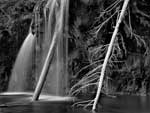Ask photographer Arlene Gottfried if she thinks the New York characters she’s shot for 40 years from Coney Island to Times Square and Harlem are freaks, and she bristles. “I don’t think they’re freaks, because then I’d be a freak, too.” With her little-girl Coney brogue (she and her brother, manic comic Gilbert, grew up there), old-soul eyes, and longtime avid membership in the Jerriese Johnson East Village Choir (she occasionally solos, she boasts), she’s a quiet defender of the grimily vibrant denizens of an older New York that’s disappearing daily. Now she’s their enshriner, too: Due out this week from powerHouse Books, Sometimes Overwhelming compiles images Gottfried took of the city in the seventies and eighties. An exhibit of Gottfried’s later work is also opening March 5 at the Alice Austen House Museum on Staten Island.
We interviewed Gottfried about some of her most striking images. An exclusive preview of photos from her book, and her memories of taking them
Check it out here.












